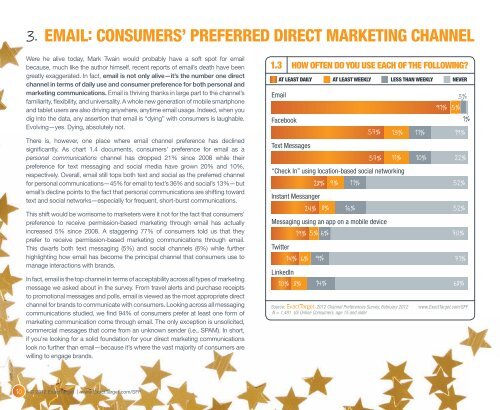The 2012 Channel Preference Survey (PDF) - Prisa Digital
The 2012 Channel Preference Survey (PDF) - Prisa Digital
The 2012 Channel Preference Survey (PDF) - Prisa Digital
You also want an ePaper? Increase the reach of your titles
YUMPU automatically turns print PDFs into web optimized ePapers that Google loves.
3.<br />
EMAIL: CONSUMERS’ PREFERRED DIRECT MARKETINg ChANNEL<br />
Were he alive today, Mark Twain would probably have a soft spot for email<br />
because, much like the author himself, recent reports of email’s death have been<br />
greatly exaggerated. In fact, email is not only alive—it’s the number one direct<br />
channel in terms of daily use and consumer preference for both personal and<br />
marketing communications. Email is thriving thanks in large part to the channel’s<br />
familiarity, flexibility, and universality. A whole new generation of mobile smartphone<br />
and tablet users are also driving anywhere, anytime email usage. Indeed, when you<br />
dig into the data, any assertion that email is “dying” with consumers is laughable.<br />
Evolving—yes. Dying, absolutely not.<br />
<strong>The</strong>re is, however, one place where email channel preference has declined<br />
significantly. As chart 1.4 documents, consumers’ preference for email as a<br />
personal communications channel has dropped 21% since 2008 while their<br />
preference for text messaging and social media have grown 20% and 10%,<br />
respectively. Overall, email still tops both text and social as the preferred channel<br />
for personal communications—45% for email to text’s 36% and social’s 13%—but<br />
email’s decline points to the fact that personal communications are shifting toward<br />
text and social networks—especially for frequent, short-burst communications.<br />
This shift would be worrisome to marketers were it not for the fact that consumers’<br />
preference to receive permission-based marketing through email has actually<br />
increased 5% since 2008. A staggering 77% of consumers told us that they<br />
prefer to receive permission-based marketing communications through email.<br />
This dwarfs both text messaging (5%) and social channels (6%) while further<br />
highlighting how email has become the principal channel that consumers use to<br />
manage interactions with brands.<br />
In fact, email is the top channel in terms of acceptability across all types of marketing<br />
message we asked about in the survey. From travel alerts and purchase receipts<br />
to promotional messages and polls, email is viewed as the most appropriate direct<br />
channel for brands to communicate with consumers. Looking across all messaging<br />
communications studied, we find 94% of consumers prefer at least one form of<br />
marketing communication come through email. <strong>The</strong> only exception is unsolicited,<br />
commercial messages that come from an unknown sender (i.e., SPAM). In short,<br />
if you’re looking for a solid foundation for your direct marketing communications<br />
look no further than email—because it’s where the vast majority of consumers are<br />
willing to engage brands.<br />
10 © <strong>2012</strong> ExactTarget | www.ExactTarget.com/SFF<br />
1.3<br />
HOW OFTEN DO YOU USE EACH OF THE FOLLOWING?<br />
AT LEAST DAILY AT LEAST WEEKLY LESS THAN WEEKLY NEVER<br />
Email<br />
Facebook<br />
Text Messages<br />
“check In” using location-based social networking<br />
Instant Messanger<br />
3%<br />
91% 5%<br />
1%<br />
57% 13% 11% 19%<br />
57% 11% 10% 22%<br />
28% 9% 11% 52%<br />
24% 8% 16% 52%<br />
Messaging using an app on a mobile device<br />
19% 5% 6% 70%<br />
Twitter<br />
14% 6% 9% 71%<br />
linkedIn<br />
10% 8% 14% 68%<br />
Source: <strong>2012</strong> <strong>Channel</strong> <strong>Preference</strong>s <strong>Survey</strong>, February <strong>2012</strong> www.ExactTarget.com/SFF<br />
N = 1,481 US Online Consumers, age 15 and older

















